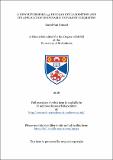Files in this item
A new reversible 1,3-dipolar cycloaddition and its application in dynamic covalent chemistry
Item metadata
| dc.contributor.advisor | Philp, Douglas | |
| dc.contributor.author | Van Brussel, David | |
| dc.coverage.spatial | xii, 177 p. | en_US |
| dc.date.accessioned | 2018-07-23T14:19:30Z | |
| dc.date.available | 2018-07-23T14:19:30Z | |
| dc.date.issued | 2016-05 | |
| dc.identifier.uri | https://hdl.handle.net/10023/15653 | |
| dc.description.abstract | In the past decades, chemists have designed and investigated artificial self-replicating molecules. A self-replicating molecule is one that can assemble its building blocks through molecular recognition, the building blocks are brought in close proximity and can react to form another copy of the self-replicator. Self-replicators are important to consider in the context of the origin of life, as it is hypothesised that molecular self-replicating entities are at the basis of the emergence of life on earth. Previously, self-replicating molecules have been reported based on cycloaddition reactions, and in particular the Philp Laboratory worked on a self-replicating system based on the cycloaddition reaction between a maleimide and a nitrone. The thesis presented here, however, focuses on the implementation of another dipolarophile in a recognition-mediated reaction with a nitrone. 2-Arylidene-1,3-indandiones can react with nitrones in a 1,3-dipolar cycloaddition and these compounds can be functionalised with a recognition site. Initially, the reactivity of the indandiones in a 1,3-dipolar cycloaddition with a nitrone is studied in the absence of recognition-mediated reaction pathways. The investigation is carried out experimentally and computationally with semi-empirical methods and Density Functional Theory. Secondly, we investigated the effect of molecular recognition on the rate and conversion of the cycloaddition reaction. Depending on the location of the recognition site relative to the reactive site on the nitrone, the rate can be accelerated up to almost seven times. Synthetic chemists, traditionally, investigate chemical reactions in isolation and one product is purified after the chemical reaction. In biochemical systems, however, a mixture of many compounds is present. In the final part of this thesis, the recognition-mediated reaction is described between the indandione and a mixture of nitrones and any difference in behaviour between the reaction in isolation and the reaction in a mixture of starting materials is investigated. | en_US |
| dc.language.iso | en | en_US |
| dc.publisher | University of St Andrews | |
| dc.subject.lcc | QD281.R5V2 | |
| dc.subject.lcsh | Ring formation (Chemistry) | en |
| dc.subject.lcsh | Molecular recognition | en |
| dc.subject.lcsh | Supramolecular chemistry | en |
| dc.subject.lcsh | Density functionals | en |
| dc.title | A new reversible 1,3-dipolar cycloaddition and its application in dynamic covalent chemistry | en_US |
| dc.type | Thesis | en_US |
| dc.type.qualificationlevel | Masters | en_US |
| dc.type.qualificationname | MPhil Master of Philosophy | en_US |
| dc.publisher.institution | The University of St Andrews | en_US |
This item appears in the following Collection(s)
Items in the St Andrews Research Repository are protected by copyright, with all rights reserved, unless otherwise indicated.

